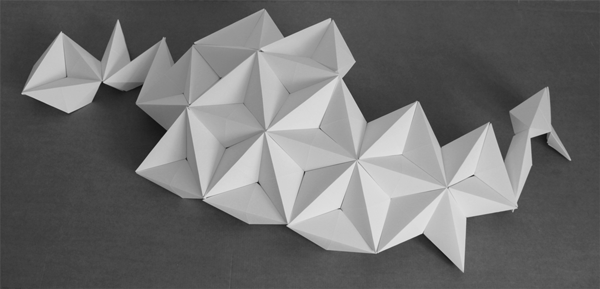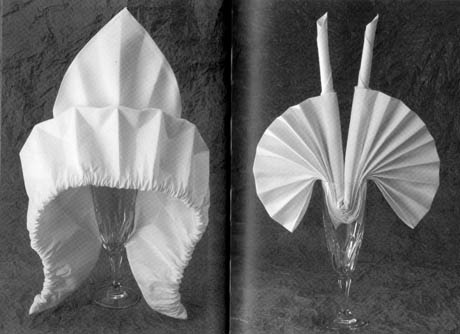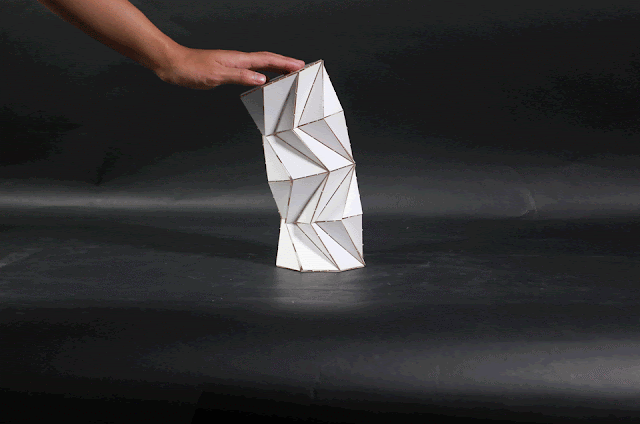ORIGAMI – A SPACE MAKING TOOL
"When you fold, the ritual and the act of creation is more important than the final result. When your hands are busy, your heart is serene" - Akira Yoshizawa
Have you ever tried making
something out of the paper in your childhood? I am sure, most of you would have
tried your hands in making paper boats with simple folds of paper. Such brief episodes
with paper made us feel mindful &
brought us sheer joy. One such art form associated with the paper is
Origami. The slow & precise act of paper fold, carefully made with presence
of mind can aid relaxation, concentration,
bring hand to eye coordination & sharpen our memory, which is the true
remedy of our times today.
This favourite pastime of Japanese people has now reached globally & has been the source of inspiration to many. Used as part of Japanese etiquette of Gift giving & paper adornments, Origami had been used as token of good luck to share with loved ones.
Fig: Origami practiced by Japanese WomenFig: Early examples of Paper folds
Tracing back to the history of Origami, one can find its origin associated with two continents far away from each other; Asia & Europe. In the Asian context, Origami found its birth with the introduction of paper in Japan in 6th century. During this time, the practice of paper folding was seen as the ceremonial Shinto ritual. During the Edo period in Japan from 1603 to 1868, with the relative peace across the Japan the economy grew, leading into dramatic development of arts & its patronage. Due to the thriving paper making industry during Edo period, the art of paper folding too flourished. In Europe however the art of paper folding was evolved from napkin-folding, a practice popularized in the 17th century. Elaborate folds to create showy table decorations in the form of animals, birds, ships etc. was developed in courts of Italy & then into Northern Europe. The European tradition of paper folding developed independently of that in Asia. In 1800s, the German educator Friedrich Froebel (creator of Kindergarten), included paper folding in the “early year’s” curriculum for the children. Paper folding was seen as a way children could discover themselves the basics of the geometry.
Fig: Napkin folding art of EuropeFig: Friedrich Froebel paper folding techniques
Making its way from the past of more than 500 years, Origami today has wider scope of applications from the fields of design to technology.
What is Origami?
Origami is a Japanese art of
paper folding, where a flat sheet of paper is transformed into a 3D sculpture
using folding & sculpting techniques. Origami word is derived from Japanese
words Ori (folding) & Kami (paper). Various aspects of Origami are
currently practiced across the globe such as Modular origami which involves fixing no. of modules in order to
form a complete composition, Pure Land
origami which is purely artistic expression of paper folds in ridge &
valley folding techniques, Wet fold
origami which involves making delicate bends where paper is made wet to
acquire desired shapes etc. to name a few. Folding Techniques such as pleat folds, ridge & valley folds,
cushion fold, kite fold, square fold are used extensively. Fold patterns such
as linear, diagonal, grid, rotational divisions, translation, reflection,
pleats, spans & perbola are used to create various shapes & forms.
Akira Yoshizawa
Considered to be the grand master of Origami, Akira Yoshizawa had mastered the techniques of paper folding by creating more than 50,000 origami models all throughout his life. Yoshizawa used traditional Origami to understand & communicate geomteric problems. He mastered a new technique called Wet folding, which involves slightly dampening the paper before making the fold giving origami its sculptural form.
Fig : Akira Yoshizawa's Origami foldsRelevance of Origami in Design fields
Origami as an art form has various characteristics such
as Shape, Form, Composition, Geometry, Fractions, Folds, Patterns, Material, Manipulation
& Action which are significant in making designs. Through the actions of bending, contracting
& expanding of simple paper folds in origami, one can develop creative visualisations for product,
buildings or spaces. Such actions can help in exploring the spatial & structural ideas, and can
act as a tool to create conceptual design
expressions for the designers. Playing with paper through origami can help
develop variety of modules which can be of both static & kinetic natures. Such modules could help develop
innovative ideas in making designs in future. Origami can also aid in academic pedagogy as an approach to
teach Design through instilling interest in drawing, folding, geometries
& math amongst the prospect learners. Origami plays important role in form finding process, promoting creative
manipulations, developing spatial perceptions etc. which are important for
designers & architects.
Skills such as Eye-hand co-ordination, patience,
sequencing ability, visualisation, processing, mathematical reasoning,
attention to details & focus are developed through Origami. Various other technical
& analytical skills such as Problem solving skills, logical thinking,
behavioural skills, thinking skills, flexibility, brain stimulation are also developed through Origami.
Application in Design
fields
Due to its unique quality of shaping up from 2D to 3D form, Origami surrounds us in almost every
endeavour today. From daily utility objects such as envelopes, paper fans,
paper bags, pizza boxes, shirt folds etc. to building forms, pavilions, shading
devices, canopies, building facades, screens, furniture designs etc. origami is
used everywhere.
Fig: Origami – Temporary shelters
The patterns or
modules created through Origami are artistically applied in designs of wall
panels, roof designs, foldable furniture’s, decorative artefacts such as lamp
shades, wall hangings etc. Origami inspired fold patterns are also utilised to
create green walls & grass mounds
in landscape designs offering unique recreational spaces. Other applications in
disciplines such as Biomedical engineering, robotics, automobiles, space
structures, biomimetic engineering, fold-cores & metamaterials are also
seen today.
Scope of Origami in future
The advent of computational data & digital
fabrication has greatly favoured to the adoption of Origami in architectural
practices. Materials such as steel, cement, polycarbonate sheets, PVC sheets,
tensile fabrics, cardboards, compressed wood, MDF sheets, overlays etc. can be
employed to achieve the desired forms.
Case studies
Case study 01: Bengt
Sjostrom Starlight Theatre, United States
This regional theatre facility located in the Rock Valley
college campus designed by Studio Gang in year 2003, uses the Origami inspired
roof to create a social setting with porous connections with the landscape
around. The kinetic roof taking inspirations from paper folding patterns, is a
fine example of application of Origami in creating space enclosures. The
kinetic roof provides enclosure to provide uninterrupted performances under the
roof during rainy season. At the same time, it provides a strong desire to
maintain the sense of being outdoors. The simple material palate such as wood
(for covering) & steel (for framework) is used for its execution.
Fig: Bengt Sjostrom Starlight Theatre, United States - – Origami application on Roof design
Case study 02: Al Bahar
Tower, Dubai
Taking ques from the traditional Islamic lattice shading
device “Mashrabiya”, the Aedas Architects have designed a responsive façade for
the project Al Bahar Towers in Dubai completed in June 2012. The interesting
feature of these towers are the computer-controlled facades which respond to
the optimal solar & light conditions. The façade treatment which explores
the kinetic composition is afforded by the Origami folds. The Origami paper
pleating techniques are one of the conceptual design approaches from which the
kinetics can be seen to have been developed. The form of the origami square
module with its folding pattern, module size & motion scenarios assures the
employability of Origami in application to modular large scale façades. Origami
can offer finite set of paper folding techniques which can be catalogued &
tested with parametric modelling software’s.
Such screens can provide efficient solution that can be utilized
externally to minimize the heat gain while providing appropriate daylighting
solutions.
Fig: Al Bahar Towers, Dubai – Origami application on Façade design
Fig: Kinetic FacadeThe above case studies outline the application of Origami into the creation of dynamic forms for the sheltering roof profile & as kinetic shading device for high-rise structures. With this considerate approach & right balance of material palate supported by apt technologies, our designs could turn into creative, beautiful as well as functional endeavours.
Conclusion
Being a simple art, involving the minimum raw material,
Origami is one of the best & easiest way to improve your skillsets. It is
an excellent way to build healthy connections on both personal &
professional levels. The self-supporting properties, kinetic behaviour, cost
effectiveness & quicker mode of construction, use of modern materials using
principles of origami could help transform the spaces & designs in future. It is truly inspiring to see how a simple
piece of paper folding, unites people across borders. So what are you waiting
for, grab your piece of paper & get started.
Written by:
Ar. Sujit Vasant Jadhav,
Assistant Professor, Thakur School of Architecture &
Planning
Mumbai
-----------------------------------------------------------------------------------
HSC in Science Stream, with 50% Aggregate and 50% Aggregate in PCM.
Qualifying Entrance Exam: NATA or JEE-Paper II
(For any details contact us)
Website: www.tsapmumbai.in
E-mail: tsap@thakureducation.org
Contact: 022-67308001/02
WhatsApp: +91-9833665446




.png)


.png)
.png)














Beautiful article and very creative work !!
ReplyDeleteYes as mentioned we made boat, rocket, paper box, photo frame, pistol by folding paper...This is the only knowledge we have about origami but your article is with so information and have detail information about origami I am impressed. Keep it up.
ReplyDeleteNice article! Very informative! Do you fold? Do you teach origami in your college?
ReplyDelete